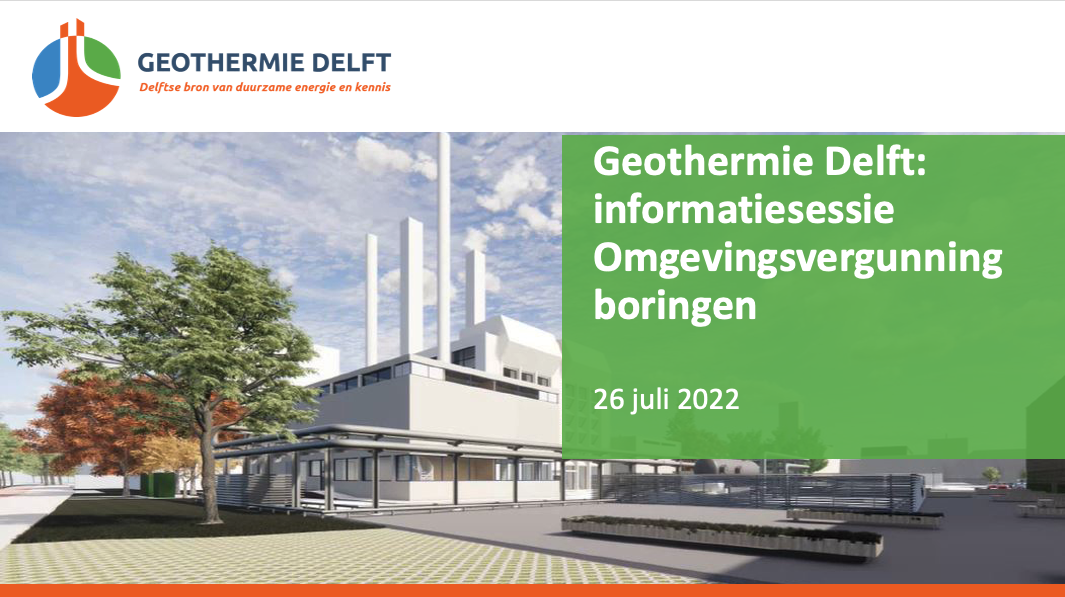On 26 July the online information meeting about the environmental permit for drilling for Geothermie Delft took place.
You can watch the information meeting via this link. The meeting was in Dutch.
Here you can read all the documentation related to the application (page is in Dutch).
The agenda was as follows:
- Introduction Geothermie Delft: Marc Pijnenborg, project leader Geothermie Delft
- Drilling process: Leendert-Jan Ursem, manager drilling: drilling process
- Licensing process: Koos Huijsmans, permits advisor
- Seismicity & vibrations: Koos Huijsmans
- BLVC plan: Marc Pijnenborg
- Questions: Marc Pijnenborg
Questions could be submitted in advance when registering for the meeting. Some of these questions have been included in the presentation. You can read this below.
The questions that were asked during the question round follow in a separate message on this site.
• Is there a risk of subsidence at Delfgauw?
There is no chance of subsidence at Delfgauw due to the drilling activities. In any case, drilling activities do not lead to subsidence outside the vicinity of the borehole. This is because the drill-hole remains very isolated from the environment by the drilling fluid and the casings. If subsidence were an issue at Delfgauw, this would have been described in the extraction plan. The extraction plan indicates that these activities have no effect on subsidence and that the risk of seismicity is low. You will be able to read this later when the extraction plan is submitted for review.
• Information about the choice of material and pumping series of the well:
In geothermal energy different materials are used to prevent corrosion. The geothermal water, the water that is pumped up, is salty and around 80 degrees. Therefore it is very corrosive. In the greater Delft area many wells are drilled with carbon steel, which is just regular steel. We are going to use chrome steel here in Delft. 13\\\\\\\\\\\\\\\\\\\\% of the steel is chrome. This makes it an expensive project, but this is also one of the research focuses of TU Delft. Some wells in the area also use GRE, Glassfiber Reinforced Epoxy, which we will not do here. We're going to use chromium here to make sure we're going to achieve a lifespan of 50 years, and probably longer than that.
• Do the activities have an effect on the groundwater level?
The groundwater level in Delft is approximately 1.50-1.60m below ground level. The groundwater level will be lowered by one meter for a period of one week as a result of our activities. This is the only effect of this project on the groundwater level. That is a regular construction activity. The water that we will soon extract at a depth of 3km contains a rock layer that is closed off by another layer. Extracting the water at a depth of 3 km has no effect on the groundwater level.
• Who will earn from it?
There are four initiators, the shareholders of the project: TU Delft, Aardyn, EBN and Shell Geothermal. Starting, the four shareholders will have to make the investments before production can take place. Ultimately, during the production phase, there will be revenues that will repay the investments. This project is crucial for the geothermal sector and also for the shareholders. We also see the importance for this project in the research component in particular. This will probably help enormously to scale up geothermal energy in the built environment.
• Which houses in the area are eligible for connection to the heat network? When will this heat network be installed?
The development of the heat network is currently ongoing. On one side of the Schie you have the TU Delft, there is already a stock residual heat network present. An expansion is also planned for this network. The Delft Open Heat Network project is underway on the other side of the Schie. The Voorhof and Buitenhof districts will initially be connected to this. This concerns buildings of four housing associations (Woonbron, DUWO, Vestia and Vidomes). These are the parties that make this project possible and also help to realize the plant. In the follow-up phase, other buildings in these districts will also be able to be connected. We cannot yet say exactly what this trajectory and term will look like. In any case, as far as the source is concerned, there is enough heat available to expand all of this. After the Voorhof and Buitenhof districts, other districts will also be connected. This is described step-by-step in the heat plan of the municipality of Delft.
